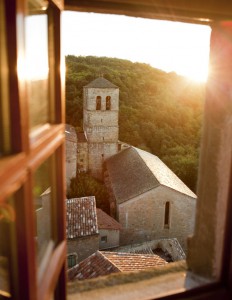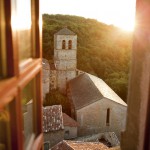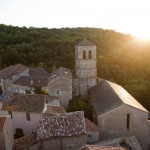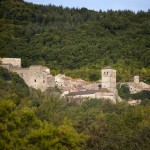History of Boussagues
Boussagues – A fortifed Village in the Languedoc
 In 863, Charles the Bald ordered the fortress of Boussagues, amongst others, to be demolished. The name of the site appears thus in historical records. At the present time there is no evidence of its origins further back than this.
In 863, Charles the Bald ordered the fortress of Boussagues, amongst others, to be demolished. The name of the site appears thus in historical records. At the present time there is no evidence of its origins further back than this.
The first mention of a Lord of Boussagues, in 1117, is of Deodat and his submission to his overlord, Bernard-Aton Trencavel, Vicomte of Béziers, (who was keen to retain his influence in the face of the powerful Counts of Catalonia and Toulouse). From the mid 12th Century the two castles towered over the village, The Château Haut was a Donjon used a a final point of defence and Chateau Bas which was the Home to the Barons of Boussagues.
The argentiferous lead mines, upon which the feudal rights of the lords of the valley (Faugeres, Villemagne, Boussagues and their overlords) were defined in 1163, ensured that the Baron had considerable revenues. As well as agriculture and the rearing of livestock, wine-making and commerce were developing rapidly. At the beginning of the 13th Century the coal mines of the Barony (Boussagues, Camplong, Graissessac) were worked by associations of shareholders. The concessions were leased for a limited period initially, but soon after indefinitely.
At it’s height, the village, separated since the 1300′s from the nucleus surrounding the Chateau Haut, spilled over the Ramparts into two new neighbourhoods: the ‘Barri Vieux’ to the South and the ‘Barri Haute’ to the North. A new cemetery and a chapel (the Trinity) also appeared outside the walls. In the region itself, the Albigensian Crusade actually benefited the Boussagues family. They bought back the feudal rights confiscated from a neighbouring lord who had been declared.
In 1348 the Plague devastate the Languedoc, as did the rest of Christendom. However, it’s impact on the population was not as drastic as had been supposed. The and the Priest survived as well as a number of families whose inheritance was increased by the deaths of possible co-heirs.
The Consuls were elected in 1364 by 115 men from the Siegnory, assembled , as was customary in the courtyard of the Chateau Haut. In fact, the decline of Boussagues resulted primarily from it’s remote location in the valley, which itself was isolated from the development of the plain of Languedoc.
The direct and indirect effects of the Hundred Years War were probably important too. Bédarieux was occupied in 1365 by free companions who held surrounding areas to ransom. The number of ‘Hearths’ (in fiscal terms, used to establish the basis of tax) fell from 62 in 1377 to 26 in 1380. Nevertheless this was only a relative decline and the 15th Century could still show some signs of life. The last of the direct descendants of the Boussagues line died in 1348 and the fief was handed down to a multiplicity of heirs: the lesser nobility of the barony still lived around the main square. There was a ‘Coppersmiths Street’ and the poorhouse was run with the revenue from it’s land assets (designed to take in the Barony’s poor, it survived until the end of the 17th Century).
In 1519, half the fief was purchased by the chapter of St Nazaire de Béziers, who sold it in 1569 to a certain Pierre Seguin. The latter, with his son-in-law D’Alichou de Sénegra, had built the East Wing and corner turret of the Château Bas together with the Maison Bailly, but this was the final flourish, for, apart from some rebuilding and new fortifications at the time of the Wars of Religion (apse of the Church of Notre Dame and the top of Our Lady’s Gate), history has little more to say about the Seignory. The mines were abandoned, the new masters far away and activity limited to agriculture and livestock. Slowly fading away, the last blow was dealt in 1884 when Boussagues lost the title of Commune to become just a hamlet of La-Tour-sur-Orb.




